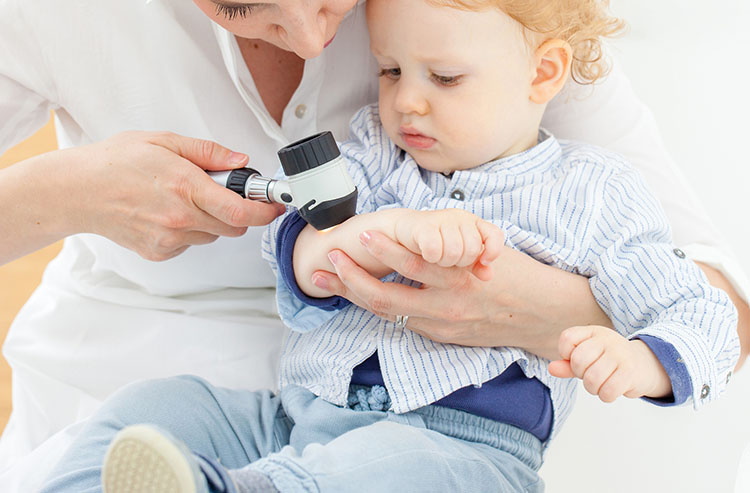Specialised Paediatric Dermatology Services in Chelsea and Battersea
Does your child need expert care for a skin condition? Our paediatric dermatology services in Chelsea and Battersea provide gentle, effective treatments tailored to children’s unique skin needs. Trust our experienced team to support your child’s skin health in a compassionate and caring environment.
Comprehensive Care for Children’s Skin in Chelsea and Battersea
Children’s skin conditions can range from common concerns like eczema and rashes to more complex issues requiring specialist attention. Our paediatric dermatology clinic is equipped to diagnose, treat, and manage a wide variety of skin conditions, ensuring the best care for your little one.
Serving Chelsea and Battersea, we are committed to making dermatological care accessible, convenient, and family-friendly.
Common Paediatric Skin Conditions We Treat
Our team specialises in diagnosing and treating numerous skin conditions in children, including:
- Eczema (Atopic Dermatitis): Red, itchy, and inflamed skin often affecting babies and young children.
- Rashes and Allergic Reactions: Skin irritation caused by allergies, irritants, or viral infections.
- Acne in Adolescents: Managing breakouts and blemishes during puberty.
- Psoriasis: Scaly patches that may develop even in young children.
- Birthmarks and Hemangiomas: Monitoring and treating skin growths and pigmentation.
- Warts and Molluscum Contagiosum: Viral skin infections common in children.
- Cradle Cap (Seborrheic Dermatitis): Scaly patches on an infant’s scalp.
- Skin Infections: Bacterial, fungal, or viral infections requiring prompt attention.
Why Choose Our Paediatric Dermatology Services?
Parents in Chelsea and Battersea trust our clinic for exceptional paediatric dermatology care because of our:
- Child-Friendly Approach: Gentle, compassionate care tailored to children’s comfort.
- Experienced Specialists: Expertise in diagnosing and treating paediatric skin conditions.
- Advanced Treatments: Access to the latest tools and techniques for safe, effective care.
- Local Accessibility: Conveniently located in Chelsea and Battersea for stress-free visits.
Our Paediatric Dermatology Services
We offer a range of services to support children’s skin health:
- Comprehensive Skin Assessments: Thorough evaluation and diagnosis of skin concerns.
- Topical and Oral Treatments: Prescriptions tailored to the child’s age and condition.
- Patch Testing for Allergies: Identifying triggers of allergic reactions.
- Laser Treatments: Non-invasive solutions for birthmarks or other skin conditions.
- Education and Support: Guidance for parents on managing and preventing skin issues.
What to Expect During Your Visit
We strive to make your child’s experience as comfortable as possible. Here’s what to expect:
- Warm Welcome: A child-friendly environment to ease nerves and create a positive experience.
- Initial Consultation: Discuss your child’s symptoms and medical history with our specialists.
- Thorough Examination: Gentle assessment of your child’s skin using advanced diagnostic tools.
- Personalised Treatment Plan: A tailored approach designed to suit your child’s specific needs.
- Follow-Up Care: Ongoing support to monitor progress and adjust treatment as needed.
Local Expertise in Chelsea and Battersea
Our paediatric dermatology clinic is proud to serve families in Chelsea and Battersea. Whether you’re enjoying family outings at Battersea Park or the cultural experiences of Chelsea, our location makes expert care easily accessible for busy parents.
Frequently Asked
QUESTIONS
Paediatric dermatology focuses on diagnosing and treating skin conditions in infants, children, and adolescents.
Yes, a paediatric dermatologist can help manage eczema effectively and provide strategies to prevent flare-ups.
Absolutely. Our specialists are trained to treat skin conditions in patients of all ages, including newborns.
Yes, we prioritise your child’s safety by using age-appropriate and gentle treatments tailored to their skin type.
Maintain proper hygiene, use gentle skincare products, and protect your child’s skin from excessive sun exposure.
Yes, our clinics are conveniently located with easy access for families in both areas.
Book Your Paediatric Dermatology Appointment Today
Give your child the best care for their skin. Contact our Chelsea or Battersea clinic today to schedule a consultation with our paediatric dermatology specialists. We’re here to provide expert care and peace of mind for your family.

